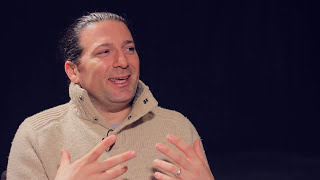In Chapter 13 of 16 in his 2012 Capture Your Flag interview, author and public speaker Simon Sinek answers "How is Your Creative Toolbox Changing?" The more Sinek practices his creative skills, the stronger his toolbox gets. He focuses on amplifying on his strengths and hiring out his weaknesses to both broaden and sharpen skills. As a lover of creative people, Sinek looks to try new things such as modern dance choreography and painting to get perspective on creative process. Simon Sinek teaches leaders and organizations how to inspire people. His goal is to "inspire people to do the things that inspire them" and help others find fulfillment in their work. Sinek is the author of "Start With Why: How Great Leaders Inspire Everyone to Take Action". He works regularly with the United States Military, United States Congress, and many organizations, agencies and entrepreneurs. Sinek is an adjunct professor at Columbia University and an adjunct staff member at the think tank RAND Corporation. Sinek earned a BA in Cultural Anthropology from Brandeis University.
Transcript
Erik Michielsen: How is your creative toolbox changing?
Simon Sinek: I’m adding to it. Right? I mean, you know, I don’t think I’ve thrown anything away. I may use some things less than I used to. But the more I learn and the more I get to practice more importantly, the more tools I’m adding to that toolbox. What’s also great is some of the tools change size, in other words, there are some tools that I really like and I’m really good with, and so I use those tools because they’re very helpful to me, and there are other tools that I’ve learned that I’m really no good with and so they’re there if I need them, you know, I’ve never understood the idea of working on your weaknesses, you know, we’re always told in our performance reviews, here are your weaknesses and these are the things you need to work on to get to the next level, I’ve never understood that, the whole idea is to work in our strengths, amplify our strengths, and we, you know, hire our weaknesses or—this is the value of a team, right? What’s the point of having a team if you have to be—if you have to improve on your weaknesses?
The whole idea is we have you on our team because you’re really good at this. You know? And we found somebody else who’s really good at this, which you’re really bad at. You guys are a team. This is the value of a team. And so I think in our workplace, our companies do us a great disservice by telling us that we have to fix our weaknesses or improve upon our weaknesses to get to the next level, they should be encouraging us and giving the tool to amplify our strengths to get to the next level, that’s what they want us for, right? Otherwise, here are your strengths and here are your weaknesses, now you’re even. Wouldn’t you wanna be this? You need to be aware of your weaknesses but we need to amplify those strengths.
Erik Michielsen: What are a couple of examples of like the creative tools that have brought that out?
Simon Sinek: I’m a lover of creative people. And so any sort of expression of how you see the world in a—with different terminology is fascinating to me. And so even though I myself am a photographer so I have that visual aspect, I’m a huge fan of modern dance and spend a lot of time sort of with dancers and in the dance world and have, you know, tried my hand at choreography just to see, you know? I’m not good. But it—I like the idea of trying it, you know? And so for me it’s about perspective, which is when I—when you hang out with dancers and you sort of learn to dance a little bit or you learn to choreograph a little bit, or you learn to paint a little bit, you know? I’m not a painter but I painted a painting recently, you know? If you—it’s like chaos theory. Everything’s connected, right? It’s like we conveniently divide up our lives, like here’s my personal life, here’s my professional life, I’m—here’s my social life, I’m looking to find balance. It’s just you. And all the same things apply. And so if you’re good here, you can apply what you learn here to there. And so when you learn how things interconnect and people interconnect, and how human relationships work, and presence, I mean you wanna learn about presence? Take a dance class. You learn all about how to present yourself and be forwards. Take an acting class, learn how to, you know, present your speech. People say, Simon, how did you learn this? It’s like—I’m exposed to all of this. So the tools I’ve learned have just mainly been different perspectives on how other people use their creative talents to see the world in it. If I can get little pieces of those, they help me in many, many different ways.























